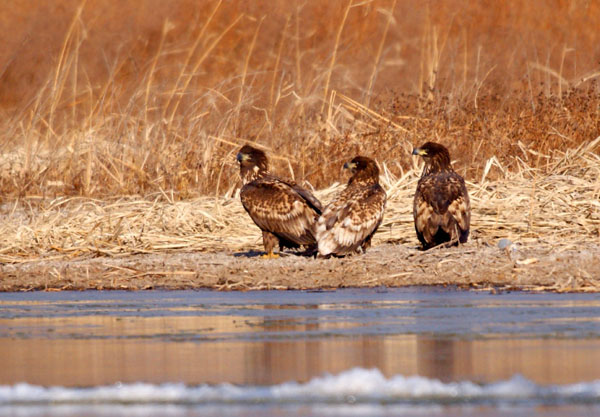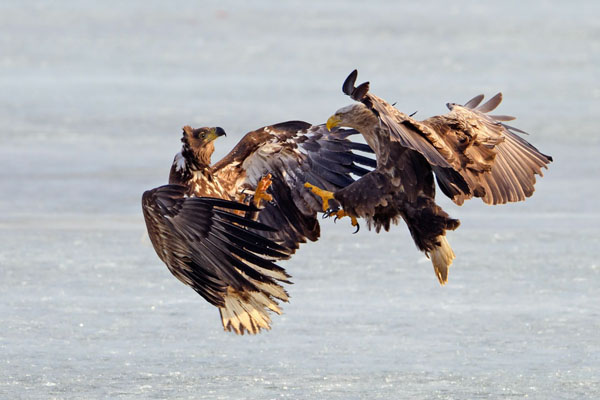Haliaeetus albicilla
IUCN
LCBasic Information
Scientific classification
- name:Haliaeetus albicilla
- Scientific Name:White-tailed sea eagle, white-tailed eagle, yellow-billed eagle, sesame eagle
- Outline:Raptor
- Family:Accipitriformes Accipitridae Haliaeetus
Vital signs
- length:84-91cm
- Weight:2.8-4.6kg
- lifetime:25year
Feature
The bark is loud, like that of a puppy or a black woodpecker.
Distribution and Habitat
It breeds in Northeast my country and Northeastern Inner Mongolia, and migrates or hibernates in the eastern coastal areas of China and parts of Central China, the river valleys of southern Tibet, and Yunnan. It is distributed abroad in the northern part of Eurasia, Greenland, and Japan, and hibernates in the southern part of these areas and in North Africa and India.
It inhabits lakes, rivers, coasts, islands, and estuaries. During the breeding period, it especially likes open lakes and rivers in waters with tall trees or forest areas.
Appearance
Large bird of prey. Monogamous. 7 wing fingers.
Adults are pure brown, with a short tail that bulges outward in the middle, white and striking, and a large yellow beak, but still far less than the Steller's sea eagle.
Immature birds are brown with irregular mottled white feathers, but their iconic white tail with black edges can still be seen, and their beaks are darker. When this species is perched, its thighs are covered with hair, and its calves are bare and yellow, and it is relatively strong.
Details
The white-tailed sea eagle lives at an altitude of 2500-5300 meters. They often live alone or in pairs near rivers, estuaries, reservoirs, lakes, coasts, and islands. In winter, this species often forms a small group of several individuals to act in unison, hovering in the sky or standing still on the ice for a long time. This species mainly preys on fish, swooping down from the air and catching fish on the water surface. In very rare cases, they will dive into the water to chase fish. If the fish is too big to catch, they will use their wings to paddle the fish to the shore, and sometimes they will wade in shallow puddles to catch fish. In addition to fish, this species also catches water birds such as ducks. They will patiently wait for the water birds that have dived to avoid to come out of the water and then attack again until the target's physical strength is exhausted. The hunting time can be as long as 45 minutes. Sometimes, two sea eagles will cooperate in hunting. In addition to fish and birds, they also eat wild ducks, geese, swans, pheasants, rodents, hares, roe deer, etc., and sometimes animal carcasses. The breeding season is from April to June, and each nest usually lays 2 eggs.

Studies have shown that white-tailed sea eagles need to eat about 300 grams of mammal meat or 500 grams of fish every day.
The number of this species in China is declining significantly, and the experience of the European white-tailed sea eagle protection project is worth learning from.

In the past 50 years, Europe and the international community have paid more attention to the environment around the Baltic Sea. The Baltic Sea is seriously polluted by heavy metals and pesticides. Since sea eagles are at the top of the food chain, they accumulate various environmental toxins, causing their breeding success rate to drop to zero in some years. Take Finland as an example. There are a large number of white-tailed sea eagles living in Finland, but in 1966, no chicks survived.
Subsequently, many European countries have taken various protective measures, including establishing small protected areas around bird nests, reducing logging, purchasing land around bird nests, releasing non-toxic food, and prohibiting the use of chemicals. Currently, there are 5,000-5,500 pairs of white-tailed sea eagles living in Europe. The number is clearly recovering.








